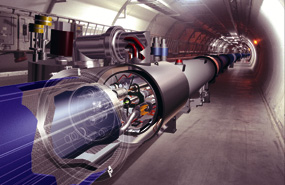The grid, a product of the CERN laboratory's development that was presented this weekend, will allow approximately 7,000 scientists from 33 countries to be connected and analyze data as part of the experiments that began last month in Switzerland on the huge hadron accelerator ● The new grid unites 100,000 processors in 140 research institutions around the world and will provide -90% of the computing requirements of the unprecedented experiment
The Giant Hadron Collider in Switzerland

The people of CERN, the world's largest laboratory for particle physics and one of the bodies that gave birth to the Internet, last weekend presented a new computer network that helps thousands of scientists around the world process data as part of large-scale experiments. About 7,000 scientists from 33 countries are currently linked in CERN's computer network and analyze data as part of the experiments that began last month at the Large Hadron Collider (LHC). The experiments, which are hoped to yield new and surprising insights into the origins of the universe, began on September 10 but were stopped nine days later, following the discovery of a helium leak in the accelerator's tunnels, which have a total length of about 27 kilometers.
When the experiments are resumed next year, the physicists who will take part in them will benefit from access to real-time data from their local workstations, with the help of CERN's new computing grid - which unites 100,000 processors in 140 research institutions around the world. The volume of data produced by the scientific experiments at the LHC is so large that it is difficult to grasp. As part of the experiment, protons are launched in opposite directions, on a collision course, in tunnels dug at a depth of about one hundred meters, in the border area between Switzerland and France.
When the particle accelerator is operating at full power, 600 million collisions between protons will occur every second, and each collision will be measured 40 million times per second. However, most of the data will be filtered and will not be used. The screening will be carried out in four huge underground detectors - the largest of which is the height of a five-story building - and the data that will be left will refer to only about a hundred collisions every second. The data will be produced at a rate of 700 megabits per second, or 15 million gigabytes per year for 15 years - a volume that could fill three million DVDs each year, or a stack of CDs more than twice the height of Mount Everest.
"The giant distributed supercomputer was originally built for the LHC project but could be used in a variety of other scientific studies," said Ian Bird, director of the LHC Computing Grid project. "Researchers and many other projects are already benefiting from the grid services," Bird said. "Grid computing offers new ways to perform scientific tasks that involve large-scale data analysis."
"In order to analyze such large amounts of data, high computing power is not enough - we also need a new paradigm, which we found in the form of the grid," said CERN spokesman James Gillis in a press briefing. Similar to the World Wide Web network, which was born in 1990 in the CERN laboratories and allows users to share information on the Internet and access it, the grid networks also allow the connection between computing resources such as storage devices and processors.
The total computing capacity of CERN can only provide about 10% of the computing requirements of the experiments that will be conducted at the LHC, and all other requirements will be provided through the grid.

3 תגובות
Is this about the BOINC grid platform? Or a grid that is closed to the general public?
per person,
The basic network that was based on Unix is a US Army development shaft.
The WWW network he is talking about was indeed based on the same military development, but was developed and implemented civilian by them...
Congratulations on a good signing.
Moses
As far as I know,
The Internet started as a project of the American military.